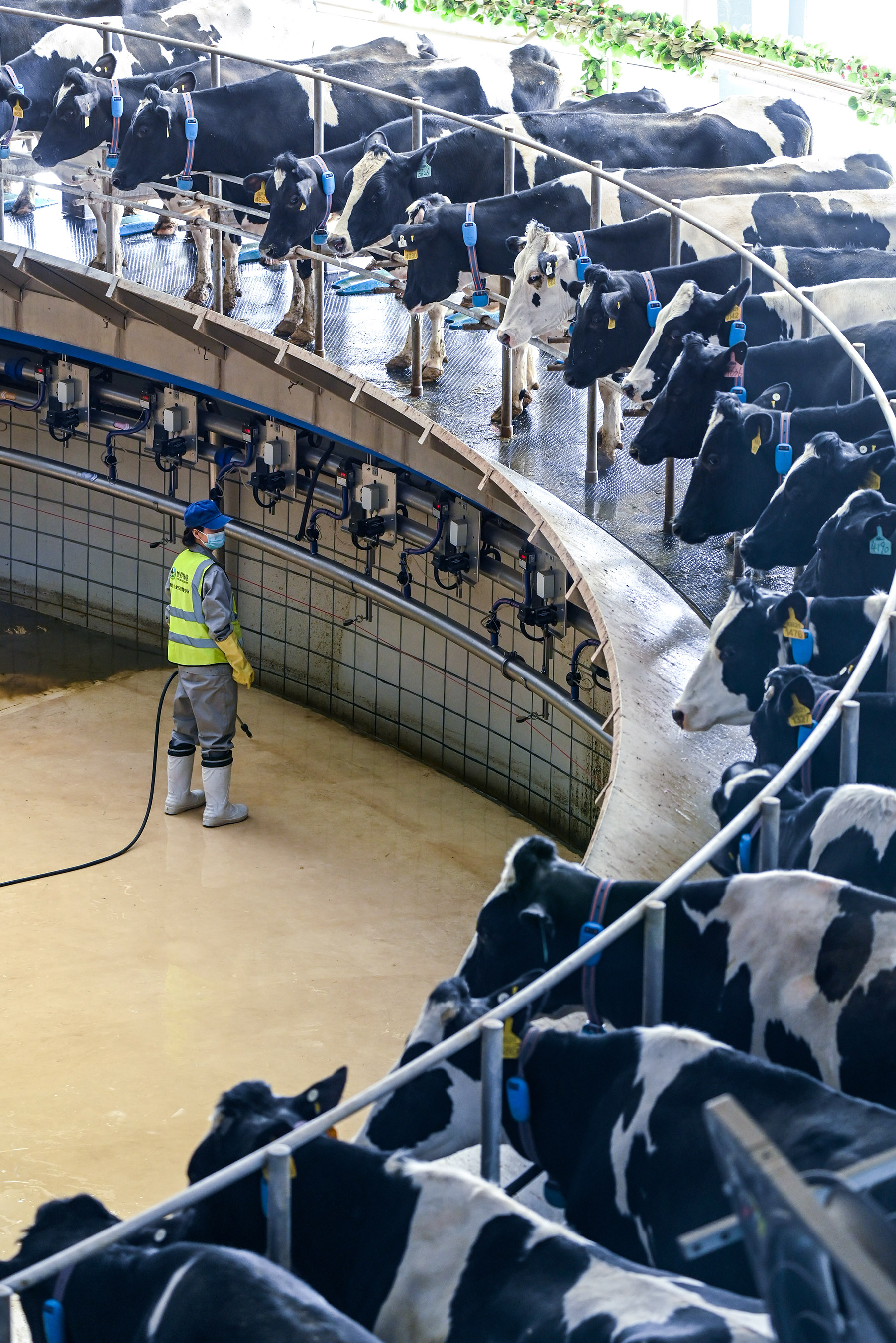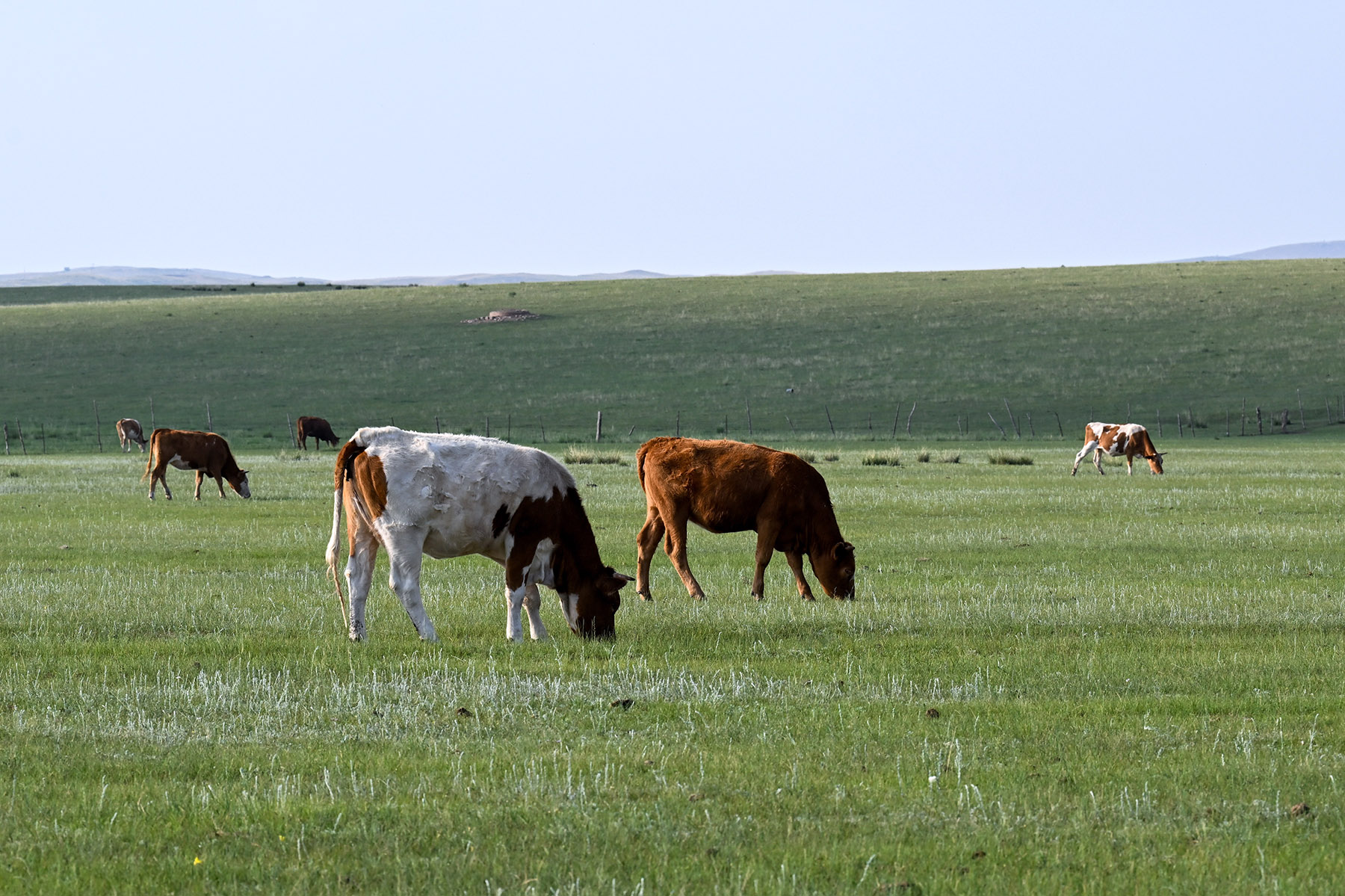Genetic selection being used to lower sector's output of methane

Editor's note: China Daily is publishing a series illustrating the country's efforts to achieve its carbon peaking and carbon neutrality goals.
With China's appetite for milk showing no signs of turning sour, a team of scientists has embarked on a groundbreaking mission in the Inner Mongolian autonomous region to create low-methane-emitting dairy cows.
Launched last year by Sk.xing, the largest cow breeding enterprise in China, the ambitious project aims to identify genes that contribute to high milk production, longevity and low emissions of methane, according to the company, headquartered in Inner Mongolia's capital Hohhot.
As the second most abundant global man-made greenhouse gas behind carbon dioxide, methane has more than 80 times the warming power of CO2 over the first 20 years after it reaches the atmosphere.
According to the International Energy Agency, the flammable gas is responsible for about 30 percent of the rise in global temperatures since the industrial revolution.
An estimated 60 percent of the world's methane emissions are from human activities, with agriculture, fossil fuel extraction and consumption, and decomposition of landfill waste as the largest sources. Agriculture, including animal husbandry, is responsible for 40 percent of man-made methane emissions.
READ MORE: New Zealand pushes back start date for price on farm emissions
Li Xihe, a leading scientist at the company, shed light on the intricate, multi-phased research involved in achieving the mission's goal of decarbonizing the dairy cow sector.
The journey begins with measuring the methane emissions of individual cows using a special device resembling a feeding trough, he said.
This cleverly designed contraption not only attracts the cows but also monitors the gases they inhale and exhale, providing valuable data for analysis.
As a ruminant animal, cows, as well as sheep and goats, host millions of tiny microbes in their stomachs. While they aid in digestion and are helpful to the livestock's health, an unfortunate by-product of their functioning is the creation of methane gas, which is expelled into the atmosphere through the animal's mouth and rear end.
The team is using mid-infrared spectra to collect methane emission data and then utilizes machine and deep learning algorithms to build a predictive model for each cow's methane output, he continued.
"With the established model, the researchers can predict the methane emission level of each cow, serving as a crucial parameter for identifying low-emission candidates," he said.

To complete the selection process, they analyze the complete genome of each cow, ultimately selecting those with both low methane emissions and desirable genetic traits, the scientist added.
Li describes the research as a meticulous process that requires time and dedication.
Developing a reliable methane emission prediction model takes at least two years, he said.
Assessing the chosen cows' milk components and mid-infrared data requires another year. Selecting cows with both high milk production and longevity while maintaining low methane emissions takes an additional one to two years.
However, more research is still needed after the low-carbon core herd is established, he stressed.
Scientists will meticulously monitor the herds' methane emissions, milk production and other vital parameters, to build a comprehensive database that confirms the low-methane status of these chosen cows.
"These exceptional cows will then form the foundation of a breeding program, producing low-methane embryos and facilitating large-scale herd expansion," he said.
Li and his team are also exploring the ideal fodder and management practices for these cows, optimizing their living environment to ensure that they fully express their low-methane genetic potential.
Sun Wei, a leading scientist with the low-carbon cow program, said over the last year a 20-strong team has been monitoring methane emissions from 8,000 dairy cows at a ranch spanning approximately 30 hectares.
With only one device for methane monitoring, he said, the team often operates in two shifts around the clock to maximize the use of the facility so as to help expedite data collection and enlarge their data pool.
Currently, the team's capacity only allows them to collect emission data from 30 to 40 dairy cows daily, though they are actively seeking to acquire another device to further enhance their capabilities, he said.
What has challenged the team is also the lack of experience from both at home and abroad to serve as references, he added.
The work is still in its early stages in China, he said, and while the concept of low-carbon cows has been explored by some foreign institutions, their research has primarily focused on beef cattle.
Sun highlighted the groundbreaking nature of the team's research and emphasized its potential to decarbonize the dairy cow sector, saying dairy cows are a major contributor to methane emissions.
Some studies show that a single cow on average produces between 70 and 120 kg of methane per year. Considering the burgeoning appetite for milk in China, methane emissions from the country's dairy cow sector will keep increasing.
In a recent report, the Institute of Food and Nutrition Development, an affiliate of China's Ministry of Agriculture and Rural Affairs, revealed that milk production in China surged to 42.8 million metric tons last year. This represents an annual average increase of 6.3 percent since 2018.
In 1980, the annual per capita milk consumption in China was only 1.2 kg. Last year, it had jumped to 42.5 kg, according to the institute. However, this is still only 37 percent of the global average, suggesting a vast potential for further growth.
ALSO READ: China's anti-subsidy probe into EU's challenge on dairy products to follow WTO rules
According to Li Pengcheng, vice-president of Chinese dairy giant Mengniu, currently, the annual carbon emissions from China's dairy industry are approximately 60 million to 70 million tons. This accounts for around 20 percent of the total emissions from the country's animal husbandry sector and 10 percent of its total emissions from the agricultural sector.
In addition to cultivating low-methane-emitting dairy cows through genetic selection, he also noted the optimization of fodder, manure recycling and the integration of solar energy facilities into ranches as potential solutions to decarbonize the dairy sector.
He emphasized the crucial role of technological advancements in ultimately solving methane emissions from dairy cows.
"Addressing methane emissions in the dairy industry requires technological intervention," he asserted, highlighting utilizing new technological approaches to capture and treat methane as a potential solution.
Contact the writers at houliqiang@chinadaily.com.cn


